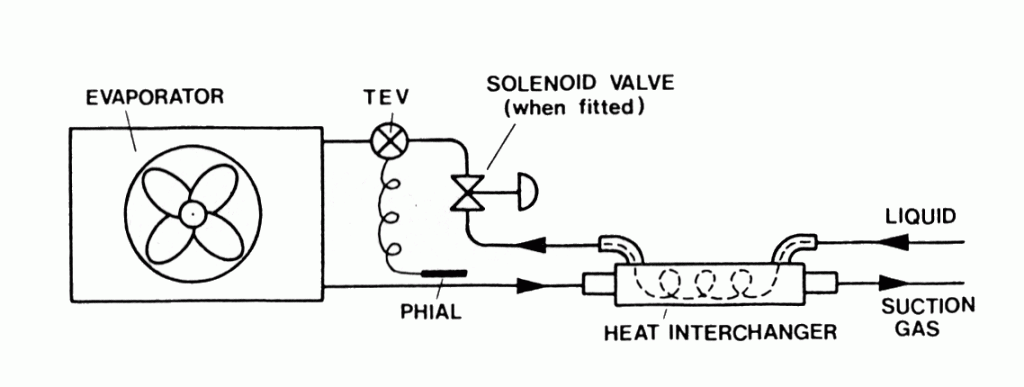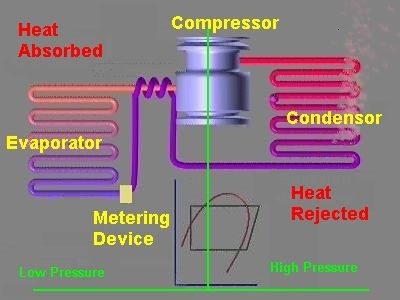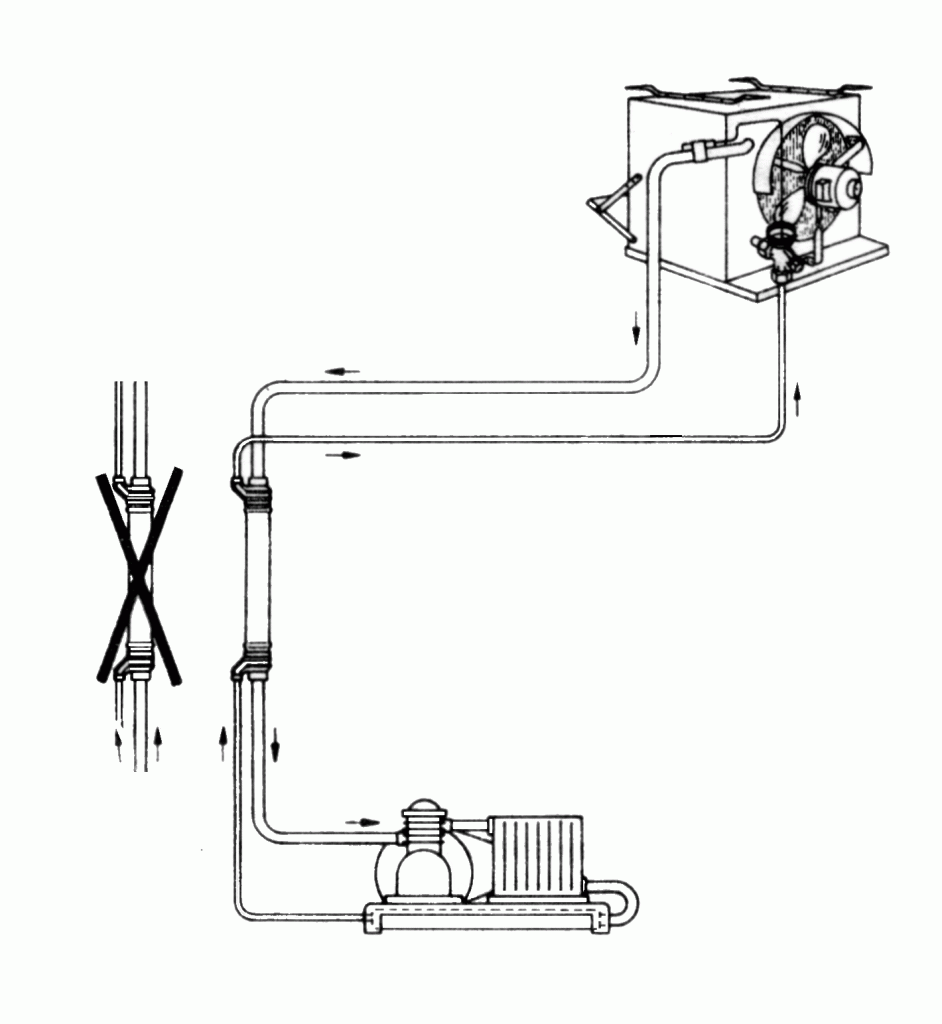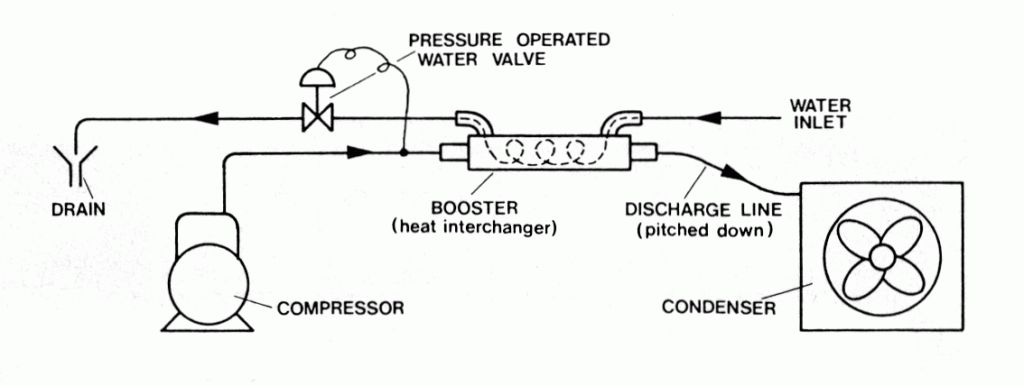
Heat Interchanger:
The use of heat interchangers, either as an aid to performance or a solution to a problem, has been custom and practice in the commercial refrigeration industry for many years, often with virtually no consideration of both theoretical or practical concepts.
They can be found applied in refrigerant systems in many different ways for many different reasons. Here we cover the most common uses these refrigerant heat interchangers.
Conventional Application:
The most common application and original concept is to install the heat interchanger adjacent to the evaporator and thermostatic expansion valve as shown in Fig 2, below:

Virtually all refrigeration systems will benefit from a heat interchanger providing it is not undersized so that the suction side pressure drop nullifies the advantages or, on low temperature applications, is oversized so that the suction superheat and consequently the discharge temperature, is too high.

In this application the heat interchanger has two effect: increasing the gas temperature (superheat) as it enters the compressor suction and increasing the degree of liquid subcooling as it enters the expansion valve.
Increasing the suction gas temperature (superheat):
In most instances this is difficult to obtain from the evaporator in low-temperature applications it is impossible, so consequently there can easily be a shortfall of 5% in the compressor rating and therefore the system capacity.
The only way that this superheat can be achieved, albeit indirectly, is from a heat interchanger which can be sized to restore and, sometimes, slightly increase the system evaporator capacity. This is achieved by superheating the suction gas and subcooling the refrigerant liquid in an exchange of heat, this sub heating then being usefully employed in the evaporator and fulfilling the requirements stated in the first paragraph.
The temperature interchange between the refrigerant vapor and the liquid is approximately equal too:
| Refrigerant type | Factor ‘C’ |
| R12 | 0.6 |
| R22 | 0.5 |
| R502 | 0.55 |
This is especially a problem on any close approach application, such as a low-temperature cold store, which must operate at low TEV superheats, conditions at which instability is always likely to occur.
If “wet” refrigerant vapor continually enters the compressor it will have a detrimental effect on the lubricating system by diluting the oil and causing foaming. This can lead to excessive wear and even seizure of the moving parts.
This condition also has a de-rating effect on the pumping rate on the compressor, i.e. the system evaporator capacity, and continually washes the oil off the cylinder walls to increase the wear rate.
Increasing the degree of liquid subcooling as it enters the expansion valve:
The effective performance of the TEV and refrigeration system can only be achieved if the
Flash gas in the liquid line, resulting from either the evaporator being mounted above the condenser and/or pressure losses in the pipelines, can be eliminated by the use of a heat interchanger.

Based on refrigeration liquid at 32 ºC (90 ºF) the amount of subcooling required to compensate for these losses is:
| SI & METRIC UNITS | R12 | R22 | R502 |
| 1 bar pressure drop | 4.9ºK | 3.1ºK | 2.9ºK |
| 10m elevation difference* | 6.2ºK | 3.5ºK | 3.4ºK |
| IMPERIAL UNITS | R12 | R22 | R502 |
| 10 psi pressure drop | 6.1 ºF | 3.8 ºF | 3.6 ºF |
| 10ft elevation difference* | 3.4 ºF | 1.9 ºF | 1.8 ºF |
*not applicable when the evaporator is below the condensers.
Minimum heat interchanger superheats and the approximate related subcooling for nominal selection are: –
| APPLICATION | SUPERHEAT | SUBCOOLING |
| High temperature, room above O ºC (32 ºF) | 10 ºK (18 ºF) | 5.5 ºK (10 ºF) |
| Commercial temperature, room below O ºC (32 ºF) | 15 ºK (27 ºF) | 8 ºK (14 ºF) |
| Low temperature, room below 20 ºC (-5 ºF) | 20ºK (36ºF) | 11 ºK (20 ºF) |
The total system superheat is the above plus the TEV superheat and the subcooling is the above plus the condenser subcooling which for a condenser without a special subcooling section is about YK (5 ºF)
A realistic appraisal of heat interchanger usage would be:
| APPLICATION | USAGE |
| High temperature | Recommended |
| Commercial temperature | Essential |
| Low temperature | Essential |

Evaporator Booster:
When a heat interchanger is used in this manner the majority of the advantages listed are not applicable and it is possible on systems where the TEV is set far too low that the system will become very unstable due to the erratic temperature of the sub-cooled liquid.
This can be overcome by increasing the superheat to a more reasonable level which will achieve the objective of increasing the evaporator performance without any undue instability.
A heat interchanger selected for this type of application can be chosen for its superheating ability or the suction side pressure drop when this data is available.
Air Cooled Condenser Booster:

Only the cast aluminium type of heat interchanger can be used on this application. Air cooled condensers suffer from the fact that when their maximum performance is required the ambient air temperature is high. However, as this may only occur on a few days a year, it could be uneconomical to size the condenser for this temperature.
The use of a heat interchanger in the refrigerant discharge line between the compressor and condenser with water connected UP to the smaller connections will be capable of boosting the condenser capacity to that of a water cooled type while still retaining the advantages of the former.
